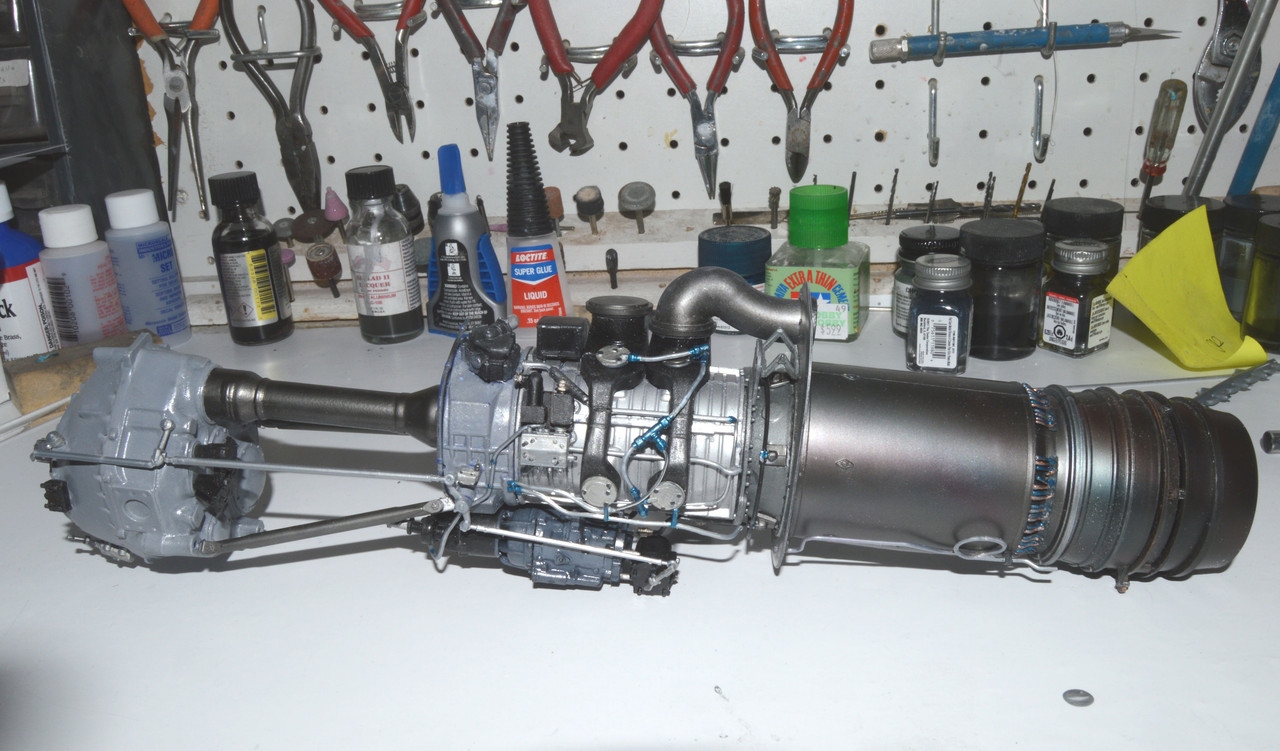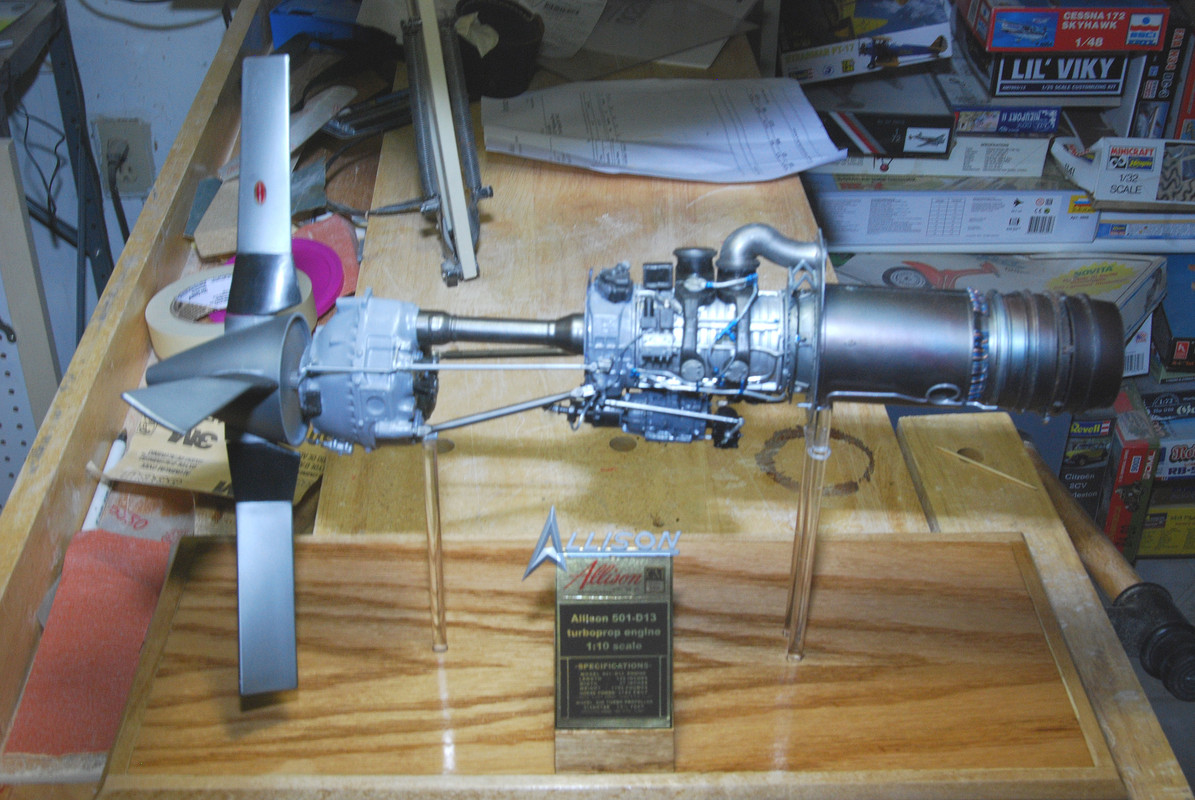Great, now I want one of these kits!
Anyone who thinks that building models is playing with toys should read this and many other posts in the various sections of this web site. the knowledge being passed on is phenominal. It includes history, mechanics, physics, philosophy, and a whole lot more.
Model building teaches some very important skills, such as following directions, hand-eye coordination, working with tools, and more. (patience?)
Keep it coming Folks. And Don, I will PM you a few picture of the bundle of control cables that run along the ceiling of the B-17G as soon as I find the right file with those pictures. Food for thought, the C-130 and the B-52 started production in the early 1950s and they are still flying. American engineering.
Oh and thank you Frank Whittle.[:D]
And if I recall correctly after doing the S2 tracker radial to turbo conversion research, the turbos are lighter than their radial counterparts.
Another long lived plane was the Beech D-18, a pre-war aircraft that was in production for many decades, and some are still flying (if they did the expensive main spar retrofit).
The British Westland Wyvern carrier based aircraft was a pretty successful design, again with a counter-rotating prop arrangement. 3500 hp plus another 1100 lbf of residual thrust. They saw action in the Suez Crisis.
The Westland Wessex helicopter was a version of the UH-34, powered by a turboshaft engine mounted in the nose where the original radial engine was mounted.
Nice job Don! You had some grief with that one and it’s really looking good.
Wasn’t it the Republic F-84H “Thunderscreach” that litterally made people sick from the noise of the supersonic prop tips?
That’s why they stick those reduction gearboxes on the front of turboprops. I’d imagine the torque multiplication from the high RPMs of the gas turbine stepped down to prop speeds must put out some incredible power. I believe making those gearboxes reliable under all that torque was a big engineering problem for a while. One they figured how to keep the gearboxes from self destructing, gas turbines driving shafts are used in all sorts of applications.
Helicopters are almost exclusively gas turbines now (Helos were really limited by piston engines, jet engines are relatively simple and light weight for the power they put out). A lot of ships have them too (destroyers and patrol ships anyway). Electric power generaton plants use them. I’m sure a lot of other stuff.
They had a good start in that recips of large power were already using reduction gears. Those huge radials like the R-2800 and the 3350 helped develop reduction gear technology. And, in the thirties when gas turbines were being developed, the original idea was the turboshaft. There were gas turbine/turboshafts of a thousand horsepower driving locomotives in Europe before the Whittle and Von Ohain engines first ran. The turbojet did not precede the turboshaft.
The big radials weren’t spinning at the RPMs of the gas turbines, but that’s interesting about the land based gas turbines with reduction gears. I wasn’t aware of that. Maybe the problems they had were due to trying to lighten the gear boxes for use with the turbines in aircraft?
Also, full frontal area of a gear box can hide in front of a big radial. Offsets work.
Therree was an interesting time where turbo props were perfomance monsters, before turbo jets were reliable.
The P-3 Orion’s origin was the Lokheed Electra. As a commercial airliner, it failed becaiuse of a failure to design a engine/ airframe solution.
But Vickers designed Viscount.
The Russians had a number of short hall Antonovs, as did the Shorts.
Got the reduction gear unit connected to the compressor/turbine unit now. Also all the bubbles, bangles and beads on the outside. Working on a display base and mount now.

I believe the train engines were steam turbines, Don. They just ran steam from a separate boiler through a power turbine to put power to the wheels. The stumbling block for all gas turbines was the power section and it’s high temperatures, which a steam turbine does not experience. The reason the Me 262 engines were so unreliable was that Germany did not have advanced enough metallurgy to build the power sections. General Electric, through it’s experience with turbochargers, added the factor that made early US turbines work, and that transferred back to Great Britain. Rolls Royce was also a factor in that after they took over Power Jets (Whittle) they aded their expertise with compressor design, which they were probably the best at in the world at the time. Until Rolls Royce sold the Nene to the USSR they were still working with the German level of technology. The Klimov KV-1 in the MiG 15 was the Nene with some development.
The Union Pacific had a fleet of true gas turbine powered locomotives in the 1950’s.
They were three section sets, including a fuel tender.
For freight service only through the lonely lands of Wyoming.

There were fifty five total.
Train men called them the “Big Blow”.
No, they were gas turbines, used in Switzerland. I believe Brown Boveri was the manufacturer. There was one used in US also, used to drive blower in steel mill.
You are doing a fine job on that Allison engine, Don. Looks good. Impressed with the painting, very convincing. [Y]
Hey, that’s awesome! It looks like it made out of metal. I can’t wait to see the finished product.
Great paint job.
Actually ships were the first to use turbines over pistons, and that change was about 1910-1920. However, the naval steam turbines needed significant (read heavy) reduction gear to get to the low RPM needed at the shafts of ships.
The reciprocating driving arms for train locomotives was highly mature. It also defined how periodic maintenance was done, too. The “final drive” on steam locomotives was all on the outboard side of the driving wheels. To have gone to shaft-driven wheels, the axle, and all the needed differentials would have to be between the wheels. A realitively inaccessible area. Also one subject to a lot of heat.
So, until electric final drive motors wer introduced, there was no reason to change from the single expansion piston used. (There were experiements to double-expansion pistons, but they just added complexity for little gain.)
UP’s gas turbine locos just drove a generator, which gave them electric power to pass to the trucks. They were supremely loud, and not terribly fuel efficient, for the horsepower delivered to the generator. Now, they had fewer parts than the V-12 and V-18 diesels. But the diesels idled better, were more familiar to the maintenance sheds & crews.
Getting an aviation-weight/efficient turbine would wait for Whittle (and his competitor over at Heinkle) in 1938. And, even then, they did not have enough practical knowledge, acquired from use, to know just how much horsepower the power turbine could actually generate. So, the early turbines just had inefficient compressor sections.
Completed the model yesterday. Sorry for the poor picture. It is a quick grab shot in my workshot. Today is not outside photography weather. High heat index and very windy. Should get nicer tomorrow or Tuesday. I’ll try to get an outdoor studio shot then.

To further the history discussions, yes, the success of Turbinia caused engineers all over the world to believe that a heated air turbine would, like the steam turbine, create a lighter, smaller prime mover. First attempts used reciprocating engines to drive reciprocating compressors and free piston burners. Low efficiency of existing IC engines and compressors made the results horribly heavy and fuel guzzlers. GE in the US and B-B in Europe did do some preliminary work, both for locomotive engines, and B-B also for stationary power plants. Continued work on compressor design, primarily rotary compressors, led to eventual success (with some metallurgy and cooling system schemes important too).
Nice finish Don, thanks for the history lesson too, neat thread and an excellent build.